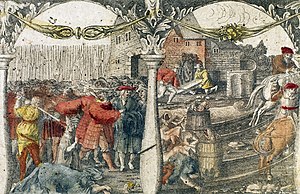
The Stockholm Bloodbath [1] ( Swede. Stockholms blodbad , dat. Det Stockholmske Blodbad ) - a mass execution that took place on November 8–10, 1520 in Stockholm by order of the Danish king Christian II .
At the beginning of 1520, the Danish king Christian II, who was seeking to restore the Kalmar Union , invaded Sweden and defeated the small Swedish army on the ice of Lake Osund . Troops mortally wounded during the battle regent Wall Sture retreated to Stockholm .

In the spring, Christian II, with the support of Archbishop Gustav Eriksson Troll, who led the Riksrod, succeeded in proclaiming himself the Swedish king. At the same time, Danish mercenaries laid siege to Stockholm from the sea and land. The siege lasted for five months, and the king was able to enter the Swedish capital only after signing the conditions offered to him: supporters of Sture cease to resist in exchange for a full amnesty, confirmation of personal and fallen possessions of the deceased’s family and complete subordination of the king to the decisions of the Rixrod.
On November 4, nobles, church servants, wealthy burghers and bonds gathered in Stockholm for coronation, followed by three-day celebrations. Even before their end, on November 7, Gustav Trolle filed a petition with the king in which he demanded compensation for his damage and named the names of the persons who were to be punished as heretics .
The next day, the palace gates were unexpectedly locked. The guests were pushed aside into the parish hall, where a little-known canon from Uppsala announced a public complaint about the insult inflicted on Gustav Troll by the late Sten Sture. Troll’s devotees in the hall depicted the church court and declared the actions of the former regent and his supporters heretical.
Executions of convicts took place on November 8, 9 and 10. On the first day, the bishops of Skara and Strangnes were beheaded on Stourtorget Square, and the next day about a hundred more were beheaded and hanged, mostly the citizens of Stockholm, who remained loyal to the Sture family. Among those executed were seven members of the Riksrod, including Gustav Vasa's father Eric Vasa, his brother-in-law Joachim Brahe and Eric Abrahamsson Leionhoodwood, as well as clergymen, noblemen, Stockholm burgomasters, fourteen advisers and about fifty well-off burghers. The remains of Wall Sture were dug out of the grave and, along with the bodies of those executed, burned in Södermalm .
The result of the Stockholm Bloodbath was an uprising led by the future king Gustav Vasa , which led to the liberation of Sweden from Danish domination.
Notes
- ↑ Writing according to the dictionary: V. V. Lopatin , I. V. Nechaeva , L. K. Cheltsova. Is it uppercase or lowercase? Orthographic dictionary. - M .: Eksmo , 2009. - P. 424. - 512 p.
Sources
- History of Sweden. - M., 1974.
- Nationalencyklopedin .
Literature
- I. Andersson. History of Sweden. - M., 1951.
- Carlsson G. Stockholms blodbad // Historisk tidskrift, 1920.
- Skyum-Nielsen N. Blodbadet i Stockholm og dets juridiske maskering - 1964.
- Weibull C. Gustaf Trolle, Christian II och Stockholms blodbad // Scandia, 1965.
- Weibull L. Stockholms blodbad // Scandia, 1928.